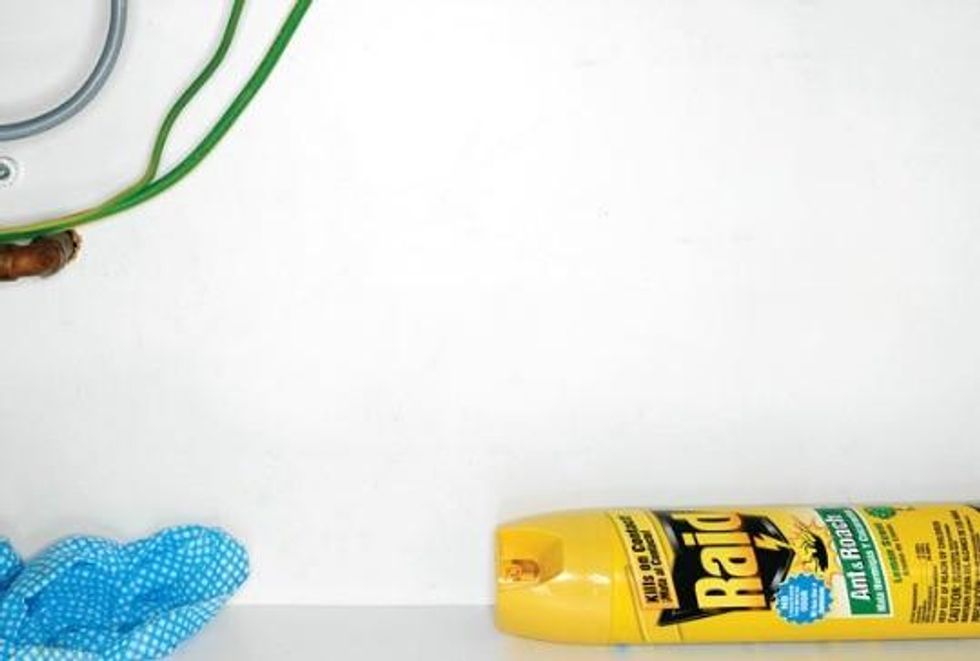

SUBSCRIBE TO OUR FREE NEWSLETTER
Daily news & progressive opinion—funded by the people, not the corporations—delivered straight to your inbox.
5
#000000
#FFFFFF
To donate by check, phone, or other method, see our More Ways to Give page.


Daily news & progressive opinion—funded by the people, not the corporations—delivered straight to your inbox.

The study also found that children in particular are still widely exposed to an insecticide that was banned for household use over a decade ago--chlorpyrifos.
"The thing to be wary of is that these products, when used inside the home, last a very long time," said Kelly Trunnelle, lead researcher of the UC Davis study.
The indoor use of pyrethroids has grown rapidly since 2001 when chlorpyrifos was phased out after it was discovered to damage neurological health.
As Shruti Ravindran at The Verge reports:
Across cities and suburbs, pyrethroids and pyrethrins are sprinkled over lawns, soaped onto pets, sprayed on offending vermin, and occasionally applied to our own persons in the form of lice-killing shampoos or mosquito repellents. They're also used in landscaping, in fumigating drives against mosquitoes, and in agricultural crops and nurseries. In 2009, the US Environmental Protection Agency (EPA) found pyrethroids and pyrethrins in more than 3,500 registered commercial products.
Over 60 percent of people examined in the study tested positive for having pyrethroids in their system.
Very few studies have examined the long-term effects of pyrethroids on humans in home-based exposure, although the research is growing. As the Sacramento Bee reports:
To date, scant research has been done on pyrethroids, which are commonly used for farming as well as in household products... However, studies on the chemical are increasing, as are concerns about its possible health effects such as endocrine disruption and autism. A 2008 study found that the pyrethroid esfenvalerate delayed the onset of puberty in laboratory rats. A UC Davis study that same year found mothers of autistic children had shampooed their pets with antiflea and antitick shampoos during pregnancy. In that study, the mothers reported they did so twice as much as mothers that gave birth to typically developing children.
"It's well-documented that pyrethroids and chlorpyrifos are more persistent in the indoor environment," Trunnelle said. "Unfortunately, this information may not be widely understood by the general public."
______________________
Dear Common Dreams reader, The U.S. is on a fast track to authoritarianism like nothing I've ever seen. Meanwhile, corporate news outlets are utterly capitulating to Trump, twisting their coverage to avoid drawing his ire while lining up to stuff cash in his pockets. That's why I believe that Common Dreams is doing the best and most consequential reporting that we've ever done. Our small but mighty team is a progressive reporting powerhouse, covering the news every day that the corporate media never will. Our mission has always been simple: To inform. To inspire. And to ignite change for the common good. Now here's the key piece that I want all our readers to understand: None of this would be possible without your financial support. That's not just some fundraising cliche. It's the absolute and literal truth. We don't accept corporate advertising and never will. We don't have a paywall because we don't think people should be blocked from critical news based on their ability to pay. Everything we do is funded by the donations of readers like you. Will you donate now to help power the nonprofit, independent reporting of Common Dreams? Thank you for being a vital member of our community. Together, we can keep independent journalism alive when it’s needed most. - Craig Brown, Co-founder |

The study also found that children in particular are still widely exposed to an insecticide that was banned for household use over a decade ago--chlorpyrifos.
"The thing to be wary of is that these products, when used inside the home, last a very long time," said Kelly Trunnelle, lead researcher of the UC Davis study.
The indoor use of pyrethroids has grown rapidly since 2001 when chlorpyrifos was phased out after it was discovered to damage neurological health.
As Shruti Ravindran at The Verge reports:
Across cities and suburbs, pyrethroids and pyrethrins are sprinkled over lawns, soaped onto pets, sprayed on offending vermin, and occasionally applied to our own persons in the form of lice-killing shampoos or mosquito repellents. They're also used in landscaping, in fumigating drives against mosquitoes, and in agricultural crops and nurseries. In 2009, the US Environmental Protection Agency (EPA) found pyrethroids and pyrethrins in more than 3,500 registered commercial products.
Over 60 percent of people examined in the study tested positive for having pyrethroids in their system.
Very few studies have examined the long-term effects of pyrethroids on humans in home-based exposure, although the research is growing. As the Sacramento Bee reports:
To date, scant research has been done on pyrethroids, which are commonly used for farming as well as in household products... However, studies on the chemical are increasing, as are concerns about its possible health effects such as endocrine disruption and autism. A 2008 study found that the pyrethroid esfenvalerate delayed the onset of puberty in laboratory rats. A UC Davis study that same year found mothers of autistic children had shampooed their pets with antiflea and antitick shampoos during pregnancy. In that study, the mothers reported they did so twice as much as mothers that gave birth to typically developing children.
"It's well-documented that pyrethroids and chlorpyrifos are more persistent in the indoor environment," Trunnelle said. "Unfortunately, this information may not be widely understood by the general public."
______________________

The study also found that children in particular are still widely exposed to an insecticide that was banned for household use over a decade ago--chlorpyrifos.
"The thing to be wary of is that these products, when used inside the home, last a very long time," said Kelly Trunnelle, lead researcher of the UC Davis study.
The indoor use of pyrethroids has grown rapidly since 2001 when chlorpyrifos was phased out after it was discovered to damage neurological health.
As Shruti Ravindran at The Verge reports:
Across cities and suburbs, pyrethroids and pyrethrins are sprinkled over lawns, soaped onto pets, sprayed on offending vermin, and occasionally applied to our own persons in the form of lice-killing shampoos or mosquito repellents. They're also used in landscaping, in fumigating drives against mosquitoes, and in agricultural crops and nurseries. In 2009, the US Environmental Protection Agency (EPA) found pyrethroids and pyrethrins in more than 3,500 registered commercial products.
Over 60 percent of people examined in the study tested positive for having pyrethroids in their system.
Very few studies have examined the long-term effects of pyrethroids on humans in home-based exposure, although the research is growing. As the Sacramento Bee reports:
To date, scant research has been done on pyrethroids, which are commonly used for farming as well as in household products... However, studies on the chemical are increasing, as are concerns about its possible health effects such as endocrine disruption and autism. A 2008 study found that the pyrethroid esfenvalerate delayed the onset of puberty in laboratory rats. A UC Davis study that same year found mothers of autistic children had shampooed their pets with antiflea and antitick shampoos during pregnancy. In that study, the mothers reported they did so twice as much as mothers that gave birth to typically developing children.
"It's well-documented that pyrethroids and chlorpyrifos are more persistent in the indoor environment," Trunnelle said. "Unfortunately, this information may not be widely understood by the general public."
______________________